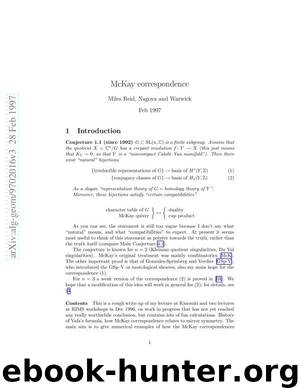McKay correspondence by Miles Reid

Author:Miles Reid
Language: eng
Format: epub
Published: 1997-02-27T16:00:00+00:00
Aj = (z, 2i, r-3i) for i = 0,..., 2k
(0,0,r)
Figure 7: G-Hilb for ^(1,2,-3). Bi is joined to A2i^2, Mi-\, Mi
to Figure |[ How do I know to join (8, 3, 2)—(2,4, 7) by a cone cr, rather than (7,1, 5)—(3, 6,4)? By calculating 2x2 minors of (247)1 we see that the parameter on the corresponding line Ecr G Y should be the ratio xz^ : y"*, where
xz
, y'^ e L(8). The Newton polygon of L(8) is
S fi 4 2 2 S 4
X X y X y X y y
(2,4,7)
xz
(8,3,2)
y2^3
(The figure is not planar: xz"^ and y'^ are "lower".) Here (2,4,7) and (8,3,2) have minima on the two planes as indicated, with common minima on xz^ and y^, so that the linear system \xz'^ : j/^| can be free on L^. But (7,1,5) and (3,6,4) don't have a common minimimum here: (7,1,5) prefers y"^ only, and (3,6,4) prefers xz^ only. If I join (7,1, 5)—(3, 6,4), the linear system \xz'^ : j/^| would have that line as base locus.
The resolution is as in Figure pi The McKay correspondence marks each
exceptional stratum: a line L parametrised by a ratio x"
is marked by
the common character space of a;"
In other words, a linear system such
(13,0,0),
(0,13,0)
Download
This site does not store any files on its server. We only index and link to content provided by other sites. Please contact the content providers to delete copyright contents if any and email us, we'll remove relevant links or contents immediately.
Whiskies Galore by Ian Buxton(41881)
Introduction to Aircraft Design (Cambridge Aerospace Series) by John P. Fielding(33064)
Rewire Your Anxious Brain by Catherine M. Pittman(18554)
Craft Beer for the Homebrewer by Michael Agnew(18142)
Cat's cradle by Kurt Vonnegut(15188)
Sapiens: A Brief History of Humankind by Yuval Noah Harari(14254)
Leonardo da Vinci by Walter Isaacson(13188)
The Tidewater Tales by John Barth(12609)
Thinking, Fast and Slow by Kahneman Daniel(12080)
Underground: A Human History of the Worlds Beneath Our Feet by Will Hunt(12025)
The Radium Girls by Kate Moore(11922)
The Art of Thinking Clearly by Rolf Dobelli(10227)
A Journey Through Charms and Defence Against the Dark Arts (Harry Potter: A Journey Throughâ¦) by Pottermore Publishing(9232)
Mindhunter: Inside the FBI's Elite Serial Crime Unit by John E. Douglas & Mark Olshaker(9206)
Tools of Titans by Timothy Ferriss(8219)
Wonder by R. J. Palacio(8011)
Turbulence by E. J. Noyes(7937)
Change Your Questions, Change Your Life by Marilee Adams(7636)
Nudge - Improving Decisions about Health, Wealth, and Happiness by Thaler Sunstein(7619)
